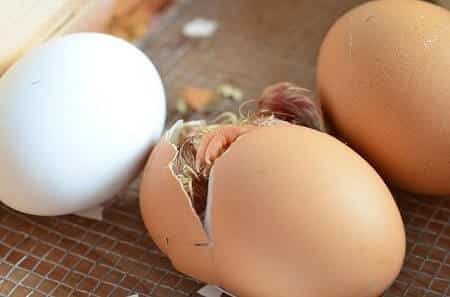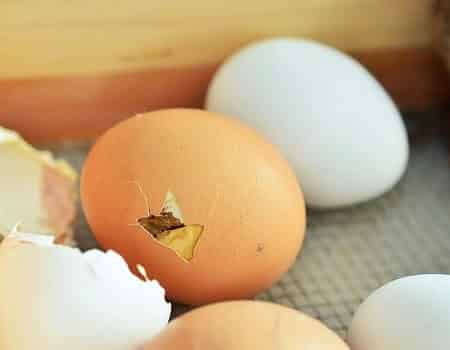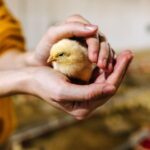If you’re hatching eggs, it can be a nerve-racking experience. All being well, you’ll notice a pip around day 20, and your baby chick should unzip and hatch on day 21.
Has your chick pipped but not hatching? If your chick has pipped the eggshell you should expect to see them starting to unzip and hatch out within 24 hours. If not, there may be a problem with the chick.
Table of Contents
What Does “Pip” Mean?
Pipping is the word to describe the first holes a chick pecks into their eggshell as they start to work their way out.
They will first make an internal pip. This isn’t visible and means they broke the air cell inside the egg. Shortly after they will make an external pip, which you will be able to see.
This might be the single most exciting part of the whole hatching process!
You’ll see a small crack or hole in the shell. When you do, you’ll know there’s only about a day left before a new chick enters the world.
What Does “Zip” Mean?
Zipping is the perfect word to describe how a chick breaks its way out of the eggshell.
Much like unzipping a zipper, they peck in a line across the eggshell until they have unzipped enough to enable them to hatch and break out.
This can take hours, and the chick will often take breaks. Which is to be expected, it’s hard work trying to break out of a shell when you’re literally hours old.
How Long From Pip to Zip?

At day 20, a chick will typically break the air cell inside the egg with its “egg tooth”. They will then “pip” the shell, which is basically the first sign that they are in the process of breaking out.
You may notice another pip mark or two that day, but you shouldn’t expect them to break out until the following day.
Day 21 is hatch day. The chick should be fully developed and have absorbed all of the yolk inside the egg, and now have the strength to break out from the shell.
It’s fascinating to witness, they use their legs and wings to line up where they want to chip away at the shell. It ends up being a line running from one side to the other, hence being called a “zip”.
So, the timeframe from pip to zip is typically around 24 hours.
What's an Egg Tooth?
I’ve said a number of times on this blog that chickens don’t have teeth. It’s true, they don’t have teeth in their mouths.
When a chick is born, they do have what’s called an “egg tooth” however.
Their egg tooth is like a small horn on the tip of their beak. They use this to break the shell and hatch from the egg.
Who would have thought it? Chicks actually come with a little power tool attached to their beaks to help them break free!
Shortly after hatching, their egg tooth will fall off as they no longer need it.
A lot of other animals that hatch from eggs also have egg teeth. Such as most reptiles, monotremes, spiders, and other creatures.
Has Your Chick Pipped but Not Zipping Yet?

The timeline from pipping to zipping is one of the most stressful and anxious parts of hatching chicks.
You know there is a chick in there ready to come out, but you’re waiting. You’re not sure how long it’ll take…. You don’t want to take your eyes off the egg and miss something…. Then there are the concerns that something might be wrong with the chick….. Argh so much to worry about.
You need to give nature every chance to do its thing without intervening. If you step in and do something too soon, you risk doing more harm than help for the chick.
Assisting a chick should be the very last resort. The most common situation where someone will know they need to help is if a chick is trying to zip, but can’t physically break the shell.
If the pipping marks are irregular, you can hear them tapping on the shell, and you’ve passed 24 hours, there is a chance they are unable to break out.
Unless you’re experienced with hatching eggs and feel confident, I’d make a quick call to your local vet for advice.
Timing is everything when assisting a chick. If they haven’t absorbed the entire yolk sack, you risk harming them. It’s not something you should do without being as sure as you can be that the chick is ready to hatch, but needs some help.
In Summary
Incubating and hatching eggs is one of the most exciting, rewarding, and nerve-racking experiences!
Around day 20, your chicks will start to pip their shells, which means they are making dents and small cracks. Within 24 hours, most chicks will start to create a line across the shell, known as a zip, to enable them to hatch.
The first time you witness this it’s like witnessing a miracle. Because it is!
If you’re past the pipping phase and waiting for the zip, try to give the chick the time they need without assisting.
Assisting hatching is a complicated, delicate, and risky thing to do. I advise acting under the advice and guidance of a vet or experienced poultry breeder where possible if you think your chick needs help.




